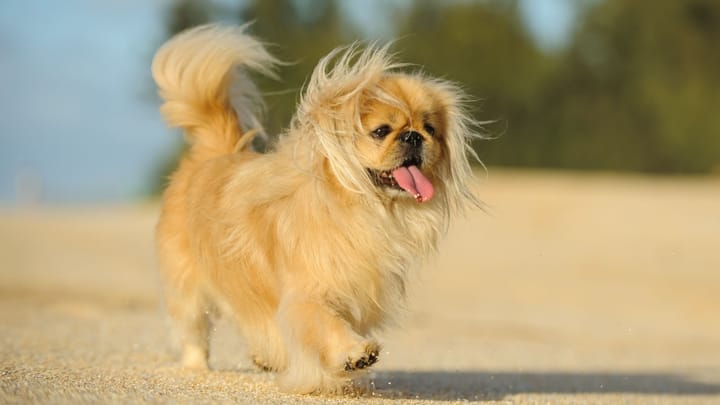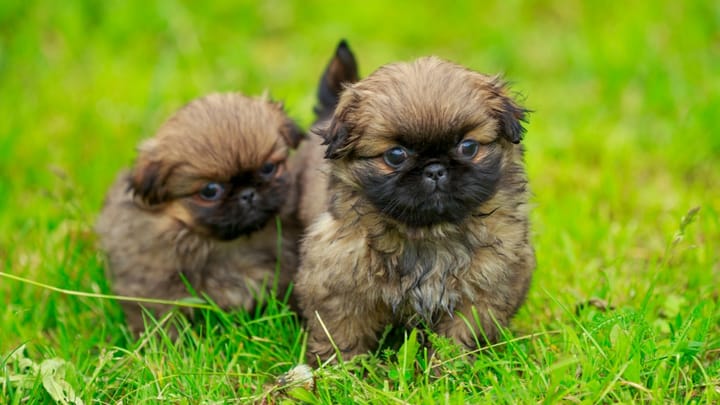Pekingese
Other names : The Lion dog, Peking Lion Dog, Pelchie Dog, Chinese Spaniel, Peke


The Pekingese dog is a short-legged dog that belongs to the group of companion dogs. However, their small size and sweet face are not to be trusted, they can quickly become aggressive if their masters do not train and socialise them from an early age.
|
Life expectancy |
The Pekingese has a life expectancy of between 12 and 14 years |
|
Temperament |
|
|
Size |
Small
|
|
Adult size |
Female
Between 6 and 9 in
Male
Between 6 and 10 in
|
|
Adult weight |
Female
Between 7 and 11 lb
Male
Between 7 and 11 lb
|
|
Coat colour
For the Pekingese, all colours and shades are allowed except albinos and brown (liver). Parti colours evenly broken are accepted. |
Black Blue Red Sand |
|
Type of coat
The coat is moderately long. The coat is straight with a mane that extends to the shoulders forming a collar around the neck. The coat is double: the topcoat is rough, and the undercoat is thick and soft. |
Long |
|
Eye colour
The eyes are dark in colour. |
Brown
|
|
Purchase price |
The Pekingese costs between £710 and £1130 |
Due to their brachycephalic morphology, the Pekingese can be very noisy (snoring, very loud breathing etc). Although it is not as bad as the French bulldog for example, it’s important to know this before adoption, even if it will often make you laugh more than anything else.
More details about the Pekingese
Pekingese: Origins and history
The origins of this breed are very old and not very clear. They can be found on bronzes from two thousand years BC. They have always been considered a sacred and precious animal and thus anyone who stole or killed a Pekingese in ancient China was punished by the death penalty. In 1860, after the destruction of the Summer Palace, only a few Beijing Dogs were found alive (they would have been killed to avoid them falling into the hands of enemies) and taken to England. One of these dogs was given to queen Victoria. Since then, the breed has been a huge success throughout Great Britain, who, along with China, has been attributed paternity of the breed.
Physical characteristics of the Pekingese
The Pekingese is a small, robust dog with a short neck and short legs. The forelegs diverge slightly from the elbow. The head is strong, wider than it is high, with a pleated frontal furrow. The stop is deep. The muzzle is broad, wrinkled, with a flat profile. The eyes are large, round, bright and prominent. The heart-shaped ears fall back with long fringes of hair on the sides of the head. The body is short. The tail is placed high, carried rigid, slightly curved above the back, with abundant fur.
FCI classification of the Pekingese
-
Group 9 - Companion and Toy Dogs
-
Section 8 : Japan Chin and Pekingese
Pekingese: Characteristics
Pekingese: Behaviour
Training a Pekingese
Obedience is not the primary quality of a Pekingese. They have a very strong character and it is necessary to have a firm, gentle and consistent attitude to achieve results with one.
Their training must begin from a very young age and must never be violent at the risk of losing the puppy’s confidence, or even worse, making your dog aggressive.
It is very important not to give into the gentle eyes of this little dog, who will use them to get away with mischief. Just because they are a small breed doesn’t mean you have to give them everything. Nevertheless, if a Pekingese interacts with a respectful, consistent and self-confident master, they will be cooperative. However, the help of an education and behavioural professional is encouraged to reduce the risk of developing bad habits.
Pekingese: Lifestyle
Breed compatibility Pekingese
Pekingese: Purchase price
The price of a Pekingese varies according to their origins, age and sex. A dog registered with the KC will cost on average £1130.
To meet the regular needs of the Lion Dog, it costs on average £25 per month (including food, veterinary care and grooming)
Pekingese: Shedding
Average
It is mainly in spring that this breed loses the most hair, so they should be brushed more regularly to remove as much dead hair as possible.
Pekingese: Grooming
The maintenance of a Pekingese can be quite complex! A visit to a professional groomer will be necessary (around every 4 months).
Regular, even daily brushing is recommended for this dog, whose coat can quickly become very dirty and tangled.
Furthermore, their eyes must be regularly monitored and cleaned as they are very fragile. Their teeth should also be examined and brushed frequently to avoid early loosening.
Pekingese: Health
They usually live for 13 years.
The Pekingese is quite a robust dog which nonetheless has some weaknesses, particularly with their eyes.
The brachycephalic morphology (squashed nose) of this breed means they aren’t good at withstanding high temperatures. Due to the breathing difficulties that this physical malformation can cause, it is not advisable to walk this dog when it is too hot as to avoid heat stroke.
Even though their coat appears to be dense, it does not provide them with optimal protection from adverse weather conditions. It is therefore not recommended to keep this animal outdoors.
If they gain too much weight, these dogs can suffer from serious health problems. Therefore, it is important to ensure that your dog is offered an appropriate diet and goes for a walk at least once a day to maintain a certain balance.
- Brain tumours
- Congenital dislocation of the elbow
- Distichiasis and Trichiasis (eyelash problems)
- Testicular ectomy (misplacement of one or both testicles)
- Hernias (inguinal, umbilical)
- Respiratory problems due to brachycephalic syndrome
- Progressive retinal atrophy




